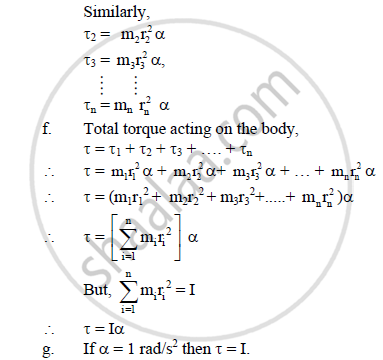Advertisements
Advertisements
प्रश्न
Obtain an expression for torque acting on a body rotating with uniform angular acceleration.
उत्तर
Expression for torque acting on a rotating body

a) Suppose a rigid body consists of n particles of masses m1, m2, m3, ......, mn which are situated at distances r1, r2, r3, …, rn respectively, from the axis of rotation as shown in figure
b) Each particle revolves with angular acceleration α
c) Let F1, F2, F3, …., Fn be the tangential force acting on particles of masses, m1, m2, m3, …, mn respectively.
d) Linear acceleration of particles of masses m1, m2,…, mn are given by, a1 = r1 α, a2 = r2α, a3 = r3α= rnα
e) Magnitude of force acting on particle of mass m1 is given by F1 = m1a1 = m1r1α [ a = rα]
Magnitude of torque on particle of mass m1 is given by,
t1 = F1 r1 sin Θ [∵ Radius vector is ⊥ar to tangential force]


Thus, when a torque rotates the body with uniform angular acceleration of 1 rad/s2 then M.I of the body about a given axis of rotation becomes equal to torque acting on it.
APPEARS IN
संबंधित प्रश्न
State the law of conservation of angular momentum and explain with a suitable example.
A stone is tied to one end of a string. Holding the other end, the string is whirled in a horizontal plane with progressively increasing speed. It breaks at some speed because ______
A 500 kg car takes a round turn of the radius of 50m with a velocity of 36 km/hr. The centripetal force is ______.
A flywheel is revolving with a constant angular velocity. A chip of its rim breaks and flies away. What will be the effect on its angular velocity?
An electron(e) is revolving in a circular orbit of radius r in the hydrogen atom. The angular momentum of the electron is (M = magnetic dipole moment associated with it and m = mass of electron)
A charged particle (charge = q: mass = m) is rotating in a circle of radius 'R' with uniform speed 'v'. The ratio of its magnetic moment (M) to the angular momentum (L) is ______
Angular momentum of the earth revolving around the sun is proportional to rn , where r is the distance between the earth and the sun. Value of n is ____________.
Two bodies with moments of inertia I1 and I2 (I1 > I2) have equal angular momenta. lf E1 and E2 are their rotational kinetic energies respectively, then ____________.
The ratio of the dimensions of Planck's constant to that of moment of inertia is the dimensions of ______.
A particle of mass m is rotating in a plane in a circular path of radius r. Its angular momentum is L. The centripetal force acting on the particle is ______.
If the angular momentum of an electron is `vec"J"` then the magnitude of the magnetic moment will be ____________.
A homogeneous disc of mass 2 kg and radius 15 cm is rotating about its axis (which is fixed) with an angular velocity of 4 radian/s. The linear momentum of the disc is ____________.
Let I1 and I2 be the moments of inertia of two bodies of identical geometrical shape. If the first body is made of aluminium and the second of iron, then ____________.
Earth revolves round the sun in a circular orbit of radius 'R'. The angular momentum of the revolving earth is directly proprtional to ______.
An electron has a mass of 9.1 x 10-31 kg. It revolves round the nucleus in a circular orbit of radius 0.529 x 10-10 metre at a speed of 2.2 x 106 m/s. The magnitude of its linear momentum in this motion is ____________.
The direction of angular momentum of particle is ____________.
A disc of moment of inertia 'I1' is rotating in horizontal plane about an axis passing through a centre and perpendicular to its plane with constant angular speed 'ω1'. Another disc of moment of inertia 'I2' having zero angular speed is placed co-axially on a rotating disc. Now, both the discs are rotating with constant angular speed 'ω2'. The energy lost by the initial rotating disc is ______.
A body is rotating about its own axis. Its rotational kinetic energy is x and its angular momentum is y, hence its moment of inertia about the axis is ______.
A particle of mass m = 5 unit is moving with a uniform speed v = 3`sqrt2` unit in the XY-plane along the line y = x + 4. The magnitude of the angular momentum about origin is ______.
The angular momentum of the electron in the second orbit of hydrogen atom is L. The angular momentum in the third orbit is ______.
Define angular momentum.
